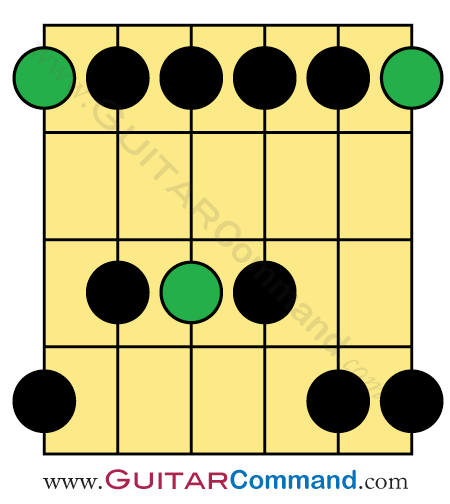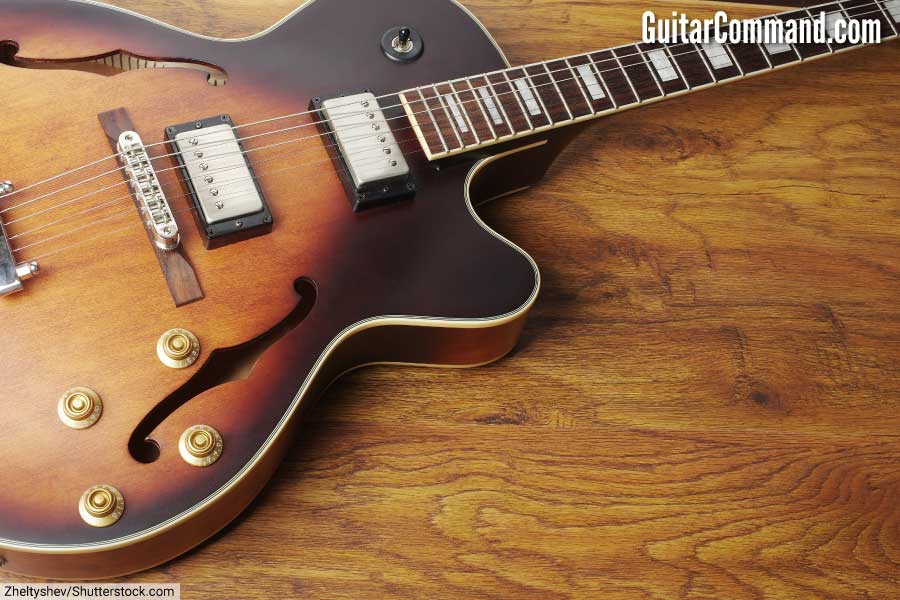On this page is a brief guide on how to play lead guitar for beginners. We cover the main playing techniques you’ll need to learn as a lead guitarist, and provide hints, tips, inspiration and links to further information on playing lead guitar.
Page Index
How To Play Lead Guitar For Beginners
Get Started Playing Lead Guitar
Intermediate Lead Guitar Techniques
Advanced Lead Guitar Techniques
Different Styles of Lead Guitar
Introduction to Lead Guitar Improvisation
How To Play Lead Guitar: Conclusion
What Is Lead Guitar?
Lead guitar takes many forms, but generally involves playing guitar solos, which are usually improvised, at certain points in a song. During a guitar solo, the lead guitarist provides the focal point of the music.
In addition to playing the guitar solos, a lead guitarist will also usually play the main riffs or guitar lines in a song, while the band’s rhythm guitarist provides a more rhythmic, chordal backing. These roles are often interchangeable, and if you’re the only guitarist in the band, you’ll have to perform both roles!

History Of Lead Guitar
Strange as it seems these days, the guitar wasn’t always a lead instrument. Back in the days of big band ensembles – long before the advent of rock and roll – the guitar was either a solo instrument (think flamenco and classical style playing), or part of a big band’s rhythm section.
The guitar simply wasn’t loud enough to solo over the large backing bands of the time.
This all changed once the bright minds at Fender and Gibson had the idea of running a guitar through an amplifier.
With their new-found sonic freedom, guitarists such as Chet Atkins, BB King, Scotty Moore, Les Paul, and countless others, pioneered the use of the electric guitar as a lead instrument.
Before long, the lead guitarist had become the focal point of a rock and roll band (well, apart from the singer), with players becoming ever more virtuosic.
How To Play Lead Guitar For Beginners

In order to play a guitar solo, a lead guitarist has to select a suitable scale (or arpeggio) in the correct key for the song, then improvise (make up) musical lines on the spot, using the notes from the chosen scale or arpeggio.
That may sound difficult, but it doesn’t have to be. Some lead guitarists will simply play an entire solo using notes from a single scale (often a pentatonic minor or blues scale).
See the Basic Theory For Lead Guitar section, below, for more information on the first scales you should learn as a lead guitarist.
There are two sides to playing lead guitar: theory and technique.
- Theory is musical knowledge – scales, chords, arpeggios, keys, etc.
- Technique is the way you physically play the guitar – from how you stand (or sit) and hold the pick, to how you fret and pick the notes themselves.
At its most basic, playing lead guitar involves improvising using scales. Technique-wise, you’ll begin playing lead guitar using a picking method called “alternate picking”.
- Improvisation is the art of composing music at the same time as playing it.
- Scales are ascending or descending sequences of notes between octaves. (You can see a wide range of scales for lead guitar on this page: Guitar Scales)
- Alternate picking is picking the notes using a strict “up, down, up, down…” motion with the pick (see further down the page for a more thorough explanation of alternate picking).
As you progress as a lead guitarist, you’ll learn more theory and more scales. Over time, you’ll learn more about selecting scales (and arpeggios) to produce the sounds you want.
Eventually, you’ll be able to play the lines you hear in your head without having to think about the theory behind what you’re playing. You’ll be able to follow complex chord progressions played at high tempos while coming up with memorable lead lines.
Get Started Playing Lead Guitar
If you’re just starting out, you’ll need to know a few basic tricks to get your head (and your fingers) around lead playing, and the theory involved. Below we describe basic lead guitar theory and the techniques you’ll need to know to get started.
Basic Theory For Lead Guitar
As a guitarist, you don’t even have to know the notes in the scale! You can learn the scales as “patterns”, or “shapes”, which can be moved up and down the guitar neck in order to play the same scale in a different key.
The first scales you should learn for playing lead guitar are the major, pentatonic minor and blues scale.

For example, the basic pentatonic minor scale shape, above, can be played at the fifth fret to produce an A pentatonic minor scale, or at the 3rd fret to produce a G pentatonic minor scale.
You can find out more about this concept (and how to read guitar scale diagrams like the one above) on this page: Guitar Scales Patterns
Once you’ve mastered the scales mentioned above, you should add the pentatonic major and natural minor scales to your arsenal.
Choose The Right Guitar Scale For A Solo
For many blues and rock songs, you’ll be able to improvise through a whole section (verse, chorus, middle 8 , etc.) using the same scale.
If the song is in a minor key, you’ll often be able to solo using the pentatonic minor or natural minor scale with the same root note as the key of the song (i.e. if the song is in A minor, you would improvise using an A pentatonic minor scale, or an A natural minor scale).
If the song is in a major key, you’ll often be able to improvise using the pentatonic major or major scale with the same root note as the key of the song.
Be aware that you might come unstuck if the song changes key, either between sections, or even during a section. If this is the case, you’ll need to select a new scale for the new key, otherwise the notes you play may not fit the music (and sound terrible!).
Basic Lead Guitar Technique
Technique is the other side of the lead guitar coin. There are a wide range of techniques employed in coaxing sounds out of an electric guitar, but to start with, you’re going to need to master alternate picking.
Alternate Picking
Alternate picking is simply picking notes with a pick*, using a strict up-down motion. The first note should be played with a downstroke, the second with an upstroke, and so on.
* Nearly all lead guitarists play using a pick, or plectrum, instead of their fingers.
More advanced picking techniques, such as sweep picking, downpicking, and economy picking, are based on your ability to pull this basic movement off without a hitch.
When you’re playing, be sure to pay attention to how each note sounds. Is it ringing out loud and clear? Are the frets rattling? Is it in tune?
If you’re getting mutes, buzzes, rattles, or off-pitch notes, you’ll need to adjust your technique to ensure that each note is beautiful and clear.
Intermediate Lead Guitar Techniques

Once alternate picking has become second nature, it’s time to add some more intermediate techniques to your playing, namely hammer-ons, pull-offs, vibrato and string bends.
Hammer-Ons And Pull-Offs
Essentially, hammer-ons and pull-offs are related techniques that involve playing notes without picking them.
It’s not magic; both techniques involve the fretting hand both fretting the notes and sounding them, all in a single physical action.
In the case of a hammer-on, the fretting finger hits the string hard enough for the note to sound without being picked.
Conversely, a pull-off involves the fretting finger forcibly moving off the fretboard (sometimes with a slight downward tug), thereby sounding a note that is being held down by another fretting finger at a lower fret on the same string.
String Bending
String bending involves picking a note, then pushing the string (usually upwards) with the fretting finger while continuing to hold the note down, thereby causing the string to bend and the pitch of the note to smoothly rise.
Guitarists often use more than one finger to provide the force required to bend the string.
Vibrato
Vibrato is a rapid, small variation of a note’s pitch. You’ll hear it in almost every lead guitar performance.
Vibrato can be very personal. Often, you can tell a guitarist simply by hearing their vibrato! You can alter the depth and speed of your vibrato to achieve the effect you want.
All you need to do to play vibrato is to pick a note and rapidly bend the string up and down (for deep vibrato), or simply pivot your wrist back and forth while holding down a note (for shallow vibrato).
Vibrato takes some work to get right, but once you’ve locked it in to your muscle memory you’ll be doing it on pretty much every sustained note you’ll ever play.
Arpeggios
Arpeggios are also known as “broken chords”, and are simply that: broken chords. Take the notes of any chord and play them one at a time, either up or down. Congratulations! You’ve played an arpeggio.
Arpeggios are useful for building melodies, outlining the theme of your solo, and, once you know them well enough, playing rapid-fire sweep picking or tapped licks.
As guitarists, we often use arpeggios in our lead playing, particularly when improvising or coming up with a melody.
Advanced Lead Guitar Techniques

Economy Picking
If your alternate picking is smooth and fast, that’s a great start. From there, you can work on economy picking, a technique invented to minimise the amount of pick-hand movement.
Economy picking is used when you change strings in the course of playing a scale or melody, etc.
Essentially, instead of picking the note on the adjacent string with the opposite picking stroke direction (as you would do in alternate picking), you play it in the same picking stroke direction – as part of the same picking motion.
For example, if moving from the 3rd to the 2nd string, you’d play both the note on the 3rd string, and the note on the 2nd string, with the same downstroke.
Confused by guitar string numbering? Check out this page: Guitar String Notes
Sweep Picking
Following on from economy picking comes sweep picking, a technique that involves playing notes on three or more adjacent strings with a “sweeping”or “raking” motion of the pick, unleashing a fast, fluid-sounding flurry of notes.
Lead guitarists such as Yngwie Malmsteen mastered this technique to produce use sweep picking to create intricate arpeggio lines.
Tapping
Tapping, as made famous by Edward Van Halen and imitated by legions of others, is like a hammer-on, except you’ll use a finger from your right hand as the “hammer”.
Using this (surprisingly easy) technique, you’ll be able to play impressive, classical-sounding licks and arpeggios that will wow your audience.
Different Styles of Lead Guitar

Improvisation has likely been around for as long as man (or our ape-like ancestors) began to sing.
It’s quite likely that the pentatonic scales that are the bread and butter of many guitar solos were among the first scales ever sung by primitive man – there’s something very primal and natural about them. These scales are an important part of traditional music in many cultures.
As traditional secular and sacred music merged and evolved into various popular styles, including rock and roll, the pentatonic scale remained a common denominator among the various offshoots.
Blues Lead Guitar
On paper, the blues is a relatively simple form of music, with essentially one main chord progression (the 12-bar blues)., over which melodies and solos are played with just three main scales: the pentatonic minor, pentatonic major, and blues scale.
Of course there’s much more to the blues than that – that single progression has a wide number of variations (and not every blues song uses it); likewise, blues solos can be embellished using a wide variety of additional scales and techniques.
Note choice, phrasing, and articulation matter more in the blues than almost any other genre. You’ll want to really nail your vibrato, expression, and your clean guitar tone to become a great blues player.
The blues scale, a variation of the pentatonic scale, is widely used in blues lead guitar. Find out how to play a blues scale on the following pages:
Rock & Metal Lead Guitar
Like the blues, rock and metal lead guitar playing relies heavily on the pentatonic and blues scales. Depending on the style of metal, you may also hear various other scales, including natural minor, harmonic minor, major, and other, more exotic scales. Arpeggios, too, are frequently utilised by metal lead guitarists.
You can see a list of scales commonly used by metal guitarists on this page: Metal Guitar Scales
Techniques such as double stops, bends, hammer-ons and pull-offs are all part of the rock and metal player’s arsenal. Metal lead guitarists are masters of alternate picking, and also incorporate advanced techniques such as sweep-picking and tapping in their solos.
Jazz Lead Guitar
Lead guitar for jazz is very cerebral, technical, and complex. It’s not at all for the faint-hearted. Great jazz players study for years, often attending specialized schools to become veritable musical encyclopaedias.
A jazz lead guitarist is expected to be able to improvise over a wide range of “standard” chord progressions. He’ll know a wide range of scales and arpeggios, and how to use them.
Jazz chord progressions often change key several times, meaning that a jazz lead guitarist won’t be able to solo away to his heart’s content using a single scale for the whole solo; he’ll have to follow the chords, making sure that a suitable scale is selected at least for each key, if not for each chord.
You can see a list of scales commonly used by jazz guitarists on this page: Jazz Guitar Scales
Introduction to Lead Guitar Improvisation
Improvisation is one of the most fun things you can do as a musician. For lead guitar, it means coming up with a solo on the spot, without any prior thought.
To improvise, you’ll need a thorough knowledge of chords, scales, and techniques.
Often, elite improvisers have melodic ideas or themes already in mind when they start soloing. This way, they can expand on the theme, play variations on the melody, and offer seemingly telepathic musical communication with the rest of the band.
Improvising, perhaps counterintuitively, is a matter of preparation more than anything else.
Preparing by regularly practising your technique, knowing your chords and scales, and having a “lick library” of go-to guitar lines you know you can unleash on an unsuspecting audience are key to becoming a great improviser.
Using Guitar Scales In Improvisation
On guitar, learning scales is easier than on other instruments, because you can learn a single shape, or pattern, for each type of scale.
As we’ve mentioned, the best scales to start with are pentatonic minor, pentatonic major, blues, major and natural minor scales.
Play them with a root note of A, (i.e. starting on the fifth fret of your bottom E string) , are a great place to begin. There’s much, much more to learn from here, but this will give you a solid foundation to start with.
Pretty much all popular music is built from the major scale. Learn which notes fall where, what scales they belong to, how they fit into chords, and what sounds good.
Don’t simply run up and down the scale, either - that’s entry level stuff. Try grouping patterns of notes, alternating up and down runs, for example in groups of three or four. This not only improves your knowledge of the scale, but will boost your technique, too.
From here, you should learn the modes and the various starting positions for each scale.
You can find out more about modes on this page: Guitar Modes
Use your scale knowledge to build your understanding of lead guitar. For example, you can play the A major scale over any song in the key of A major. However, if the song follows an A/E/Bm/D chord progression, you might choose to highlight the notes of each chord when that chord is playing. You could play A, Db, and E over the A chord, E, Ab, and B over the E chords, and so on.
Understanding scales and how they relate to chord theory is critical to being a great lead guitarist.
The great jazz lead guitar players view their lines vertically (i.e. in terms of chords) rather than horizontally (i.e. in terms of scales).
How To Play Lead Guitar: Conclusion
Playing a lead guitar solo is your chance to make your mark on a song. You’ll take the song in a new direction, adding contrast to the preceding verse and choruses.
It’s your chance to shine; if you approach a solo as a means of expressing yourself and embellishing the song, rather than just demonstrating your ability to play fast, you’ll be well on the road to becoming a great lead guitarist.


